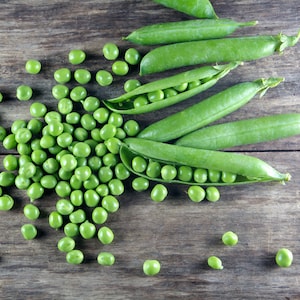What to do in your allotment in June
Written by Lee Senior
June sees mid-summer and the longest day, yet for many of us there hasn’t been much in the way of summer so far! But at least the showers have helped at planting-out time, making watering less of a burden! Most of your spring-sown plants should now be in their final growing positions, apart from any recently sown follow-on crops that you’ve earmarked for planting out later in June. If you’re late with your seed sowing, or haven’t had time this year, vegetable plug plants offer a speedy alternative and come via mail order, ready to plant out.
Given the recent weather, you’ll need to keep an eye out for slugs. Most young plants are susceptible, and also for a few weeks after planting, until their soft stems harden up. Check for damage while hoeing between rows of plants. On a dry day, simply leave the young weed seedlings to wither on the soil.
Happy growing!
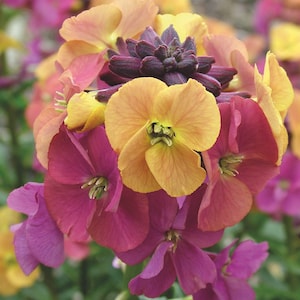
Image: Wallflower Artist Paintbox
Allotment flowers in June
- Sow sunflower seeds, cornflowers, nasturtiums and poppy seeds directly into your allotment beds this month. California poppies, calendula (orange flowered) and cosmos are three of my favourite summer annuals.
- Remember to make a good job of staking sunflowers as they’re very prone to wind damage. This can cause huge disappointment for kids and adults alike!
- Sow a tub of wildflower seeds. They attract beneficial insects like hoverflies and lacewings to pollinate your crops and prey on pests.
- It’s time to position your containers and baskets full of annual bedding plants around the allotment for bright summer colour.
- Pelargoniums (often wrongly called geraniums) can make good drought-resistant summer bedding plants. Watering requirements are a lot less than that for traditional summer bedding plants.
- Alternatively, plant up containers and baskets with herbs and allow them to flower, for a dual purpose crop and insect magnet.
- Deadhead your allotment flowers, especially sweet peas once the flowers are spent. This will encourage more flower production and prevent the plants setting seed.
Allotment vegetables in June
- Around the middle of the month, cease harvesting asparagus crowns and give a top dressing of fertiliser or manure to revitalise them.
- Continue to sow follow on crops of summer favourites such as beetroot, carrot, French beans, lettuce and turnip seeds.
- I like to sow swede seeds early in June as there’s still plenty of time for this late autumn crop to develop to maturity. Keep swede well-watered and keep a look out for flea beetle which can render the foliage full of holes.
- Direct sow herb seeds in June, especially sweet basil and coriander to use as summer crops.
- Plant out your half-hardy veg like courgettes, sweet corn, pumpkin and squashes.
- Late-sown courgettes and runner beans can both be planted out until the end of June and will grow rapidly once established. They like copious amounts of water while they’re establishing and also during any dry spells.
- There’s still time to transplant leek seedlings into their final positions. Plant them deeply in a trench or in individual holes, so that at least half of the foliage is covered by soil. Give the young plants plenty of water in the first few weeks. Some gardeners trim the foliage when they plant out. I generally don’t do this, as I’ve not found it beneficial. However, it’s good to try out new ideas, to see what works for you.
- In June, stop using nitrogen-rich feeds on your broad bean plants to reduce the risk of a blackfly infestation. Pinching the tips off your plants helps too. Ladybirds are great allies against blackfly, so encourage them to your plot by avoiding chemicals and leaving a few ‘messy’ areas for them to live.
- Cabbage collars are great when planting out young brassica plants. They deter cabbage root fly, discourage slugs and conserve moisture around the plants.
- Keep all brassicas covered and protected from the cabbage white butterfly by using a fine protective mesh. This prevents the adults from laying eggs on host plants.
- Earth up your potato plants and keep an eye out for any early signs of blight. If you haven’t managed to get yours in the ground, there’s still time. Although traditionally considered too late, tubers planted in a container or potato sack in early June can still provide a successful harvest. They should grow quickly if kept well watered and fed. Additionally, they’re quicker and easier to harvest than those in the ground.
- Pinch out the side shoots on your cordon tomato plants. When the first fruit truss sets on cordon and bush tomatoes, give your plants a feed with a high potash liquid fertiliser.
- Provide plenty of humidity around your greenhouse cucumber plants to deter red spider mite infestations. Simply spray the greenhouse paths with water on warm sunny days.
- Watch out for wind rock in taller brassicas like Brussels sprouts, especially as they get taller this month. If there’s any give around the roots in the soil or if the stem moves too much, earth up the plant base and stake the plant until the roots strengthen.
- Check your climbing and runner beans. Tie them in loosely with string if they need a bit of help climbing up their frames.
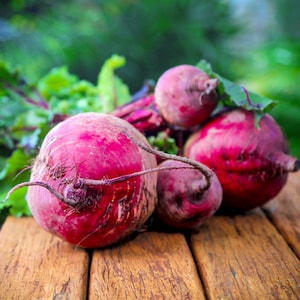
Image: Beetroot Boltardy
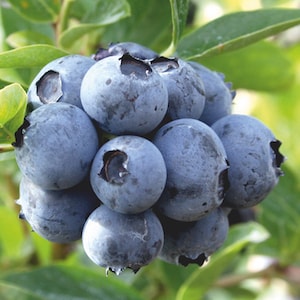
Image: Blueberry ‘Duke’
Allotment fruit in June
- Cover blackcurrants and redcurrants, whitecurrants and gooseberries with netting to prevent birds helping themselves! A fruit cage can also be a good investment as the fruit begins to develop and ripen. Blackcurrant ‘Summer Pearls’ is an early dwarf patio type that has a lovely sweet flavour.
- Redcurrant ‘Summer Pearls Red’ is a very prolific and reliable cropper. The fruit is perfect for jams or puddings and, when very ripe, I’ve even been known to eat a few straight from the bush!
- Once your strawberries have flowered and the fruit begins to set, it’s time to cover them with netting to stop birds stealing all the juicy berries.
- Blueberries are a rewarding crop to grow but they don’t like dryness at the roots. Keep them well-watered in hot dry spells using rainwater from a butt to ensure the berries reach a good size and don’t shrivel up on the plants. Always try to use rainwater to irrigate acid-loving fruits.
- Remove the flower spike from rhubarb as it develops as it’s unnecessary. Cease harvesting the crowns by the middle of the month.
- Keep an eye out for suckers on fruit trees like plums. They take away energy from the main part of the tree. Remove by pulling them rather than by cutting, where possible.
- The so-called ‘June Drop’ should occur naturally this month. This is where fruit trees like apples, pears, peaches and plums naturally shed some of their excess fruit. If, by the end of June, you can see that the tree needs a hand, remove a few more to allow the remainder of the crop to develop to a better size. Critically it also allows the tree to conserve energy for the following year.
- Water all of your fruit trees and soft fruit plants regularly this month as they start to produce crops.
Crops to harvest in June
- First early potatoes are ready to harvest this month. Prolong the harvest by only digging them up as you need them.
- Early peas should begin cropping now. Early sowings generally miss the pea moth caterpillars.
- Early sown fast-maturing pointed cabbage will be ready from mid-June onwards.
- June sees the first of the early-sown broad beans ready to harvest. There is nothing to beat the taste of the first crop of these succulent young, freshly picked beans.
- Your strawberries will be just starting to redden in June, ready to enjoy fresh from the plant.
- Start harvesting your overwintered onions and garlic this month.
- Sow lettuce, salad leaf seeds, rocket, and spinach seeds – they’ll all make a refreshing freshly picked salad on hot days.
- Rhubarb continues to give its all and can be harvested until the end of the month.
- Keep checking and picking courgettes through the next few months. They turn into marrows if not picked regularly!
- Asparagus can be harvested for the first half of June.
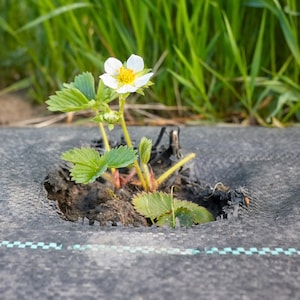
Image: Maciej Bledowski/Shutterstock
General June allotment jobs
- Donate any surplus vegetable plants to your allotment neighbours. This is preferable to overcrowding your beds, and who knows what you may get in return!
- Hoe your plot regularly using careful swift strokes between crops to nip weed plants when they’re young, before they become a chore to remove.
- Keep pests under control using slug and snail deterrents.
- If you haven’t already, install a water butt to catch rainwater. Add guttering to sheds or greenhouses to fill up your butt or make your own collector to put up in heavy rainfall.
- Keep on top of watering in June to ensure that your water-sensitive plants don’t go without. This is especially important for recent transplants and young plants that haven’t had time to develop strong root systems. These crops can struggle to get enough moisture by themselves during dry periods.
- Smother weeds using a roll of black weed suppressant (often called weed membrane). Simply lay the material down on top of any overgrown patches of earth that you don’t need to use for a while. Peg the material into the ground. Eventually all but the most pernicious weeds will die.
Planning ahead
- Make sure to leave plenty of time to visit your allotment regularly over the next few months. Summer means rampant growth and visiting the plot little and often keeps everything tidy and healthy.
- Make a plan for watering over the summer. There’s nothing worse than seeing dry allotment beds and wilting plants.
- Get ready to deal with any gluts, stocking up on jars for preserving and keeping freezer space available.
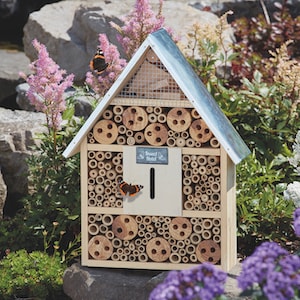
Image: Wooden insect hotel
Suttons Seeds recommend these areas which may also be of interest.
- Previous month: What to do in your allotment in May
- Next month: What to do in your allotment in July


